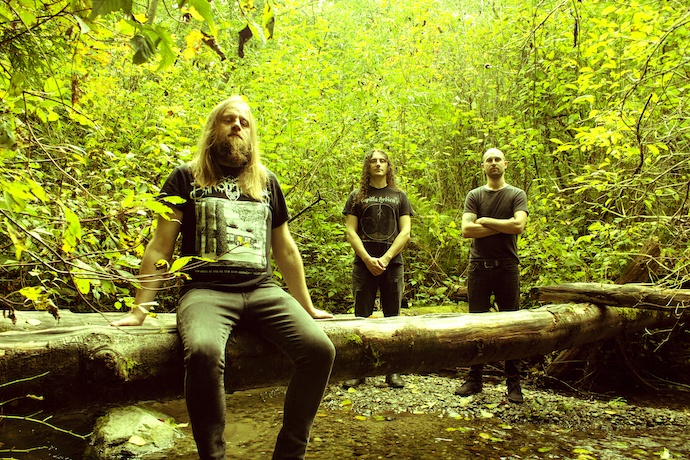
photo by Lauren Lamp
(We present Comrade Aleks‘ interview of Erik Moggridge (Aerial Ruin) and Dylan Desmond (Bell Witch), whose bands have collaborated on an album named Stygian Bough Volume 1, which will be released by Profound Lore on June 26th, and we thank Bailey Sattler and Rebecca Laverty for helping to make this discussion happen.)
Bell Witch are well-known to our readers and widely praised among modern doom metal bands as one with unique vision and inspiration, varying from funeral doom to sludge. Started in Seattle, 2010, as a duet of Dylan Desmond (bass, vocals) and Adrian Guerra (drums, vocals), Bell Witch brought forth three full-length works, though the last one, 2017’s fantastic Mirror Reaper (2017) appeared after Adrian’s death and featured the work of Jesse Shreibman (organ, drums, vocals). And as Dylan has continued Bell Witch’s toll as a duet alongside Jesse, there was always another man who took part in all the band’s albums as an honoured guest.
And that man is Erik Moggridge, who performed guitars in the legendary death / thrash crew Epidemic back in late ’80s and in the psycho death experiments of Old Grandad. Who could have predicted that his acoustic project Aerial Ruin would inspire such deep devotion among fans and would take part in a tight collaboration with Bell Witch? What do both projects have in common? What led to their fresh collaboration, Stygian Bough: Volume 1? We’ll find out in this inspiring interview together with Dylan and Erik themselves!
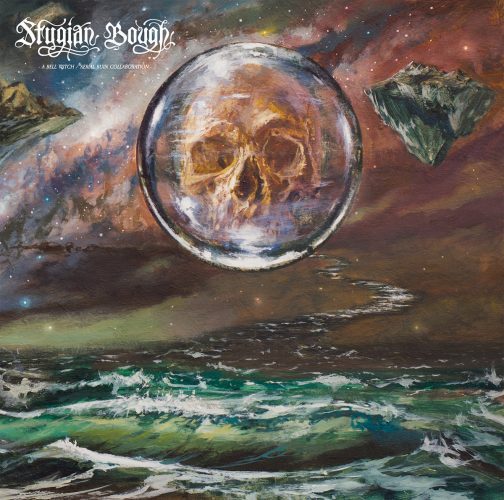
Hello Dylan and Erik! Thanks for your time, it’s much appreciated! So, the release of your collaboration album is confirmed and Stygian Bough: Volume I should see the light of day on the 26th of June through Profound Lore Records despite the quarantines and crises which have hit the music industry hard. So who initiated this collaboration? Which factors pushed you to try and join your efforts working in one direction?
EM: I think Dylan suggested it after we had been talking about doing a split where we covered each other’s songs. As much as I would have loved to hear Bell Witch play Aerial Ruin songs and play Bell Witch songs acoustically, I am glad we went this route and just joined our creative forces instead.
DD: The collaboration between Aerial Ruin and Bell Witch first occurred on the song ‘Rows (of Endless Waves)’ on the Bell Witch album Longing. There has been an Aerial Ruin track or section on each album following. When we initially discussed the collaboration there were a few ideas; the leading idea was a split album where Bell Witch covered an Aerial Ruin song and Aerial Ruin covered a Bell Witch song. I think an element I was nervous about with collaboration was the instrumentation and volume of Bell Witch having a negative effect on the lonely and stark approach of Aerial Ruin. The first track we began working on was ‘The Bastard Wind’ and the way we approached its acoustic intro quickly eased that nervousness. The approach I was envisioning was something of Ulver’s Kveldssanger and it was able to blossom into its own.
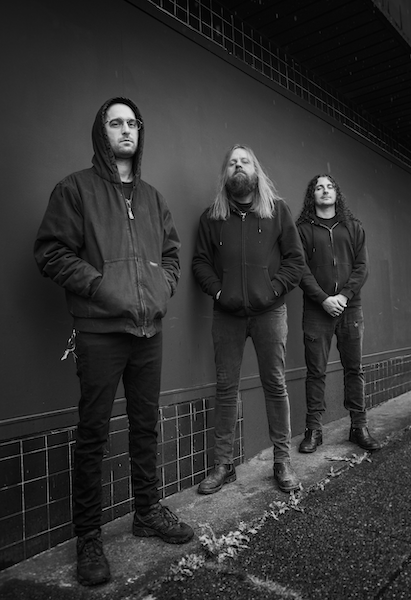
photo by Makenzie Stone
“Funeral doom” means “mourning” as the leading theme, and some forms of folk music naturally deal with this theme very effectively. How did you see the interaction between Bell Witch’s funeral doom and Aerial Ruin’s folk when you were discussing the idea of the collaboration?
DD: I’ve always felt like the two projects had a lot of overlapping musical and lyrical approaches anyways. Further, Erik’s involvement with Bell Witch over the years made him all the more familiar with the direction we go in.
EM: We initially discussed a purely acoustic album but quickly realized we wanted to have it be a largely metal album with all the Bell Witchian hugeness, but also include some material in the Aerial Ruin style. The naturalness of this interaction is exemplified in opening song ‘The Bastard Wind’, which starts in the Aerial Ruin acoustic style, soon joined by bass, then organ, before being carried into a very different and much heavier, louder Bell Witchian listening experience. I really enjoyed writing/collaborating in multiple styles for this album and perhaps most importantly enjoyed the parts of it where a new sound started to emerge.
Stygian Bough is served as collaboration, not another Bell Witch or Aerial Ruin album. How did you share your duties during the work on this material?
EM: We wrote both separately, trading recordings remotely and then I would drive up to Tacoma quite regularly and spend three or more days at a time where we would spend 10-12 hours writing and demoing together in the practice space. We naturally fell into our roles of how we contributed to the material without any need of overthinking it.
DD: The songs were mostly written in sections focused on either an Aerial Ruin centric or Bell Witch centric approach, then elaborated on accordingly to accommodate the other project’s approach. I think the outcome was less of a “cut and paste” of each project and more of a unique approach. Moving forward, I’m very excited to explore this direction deeper.
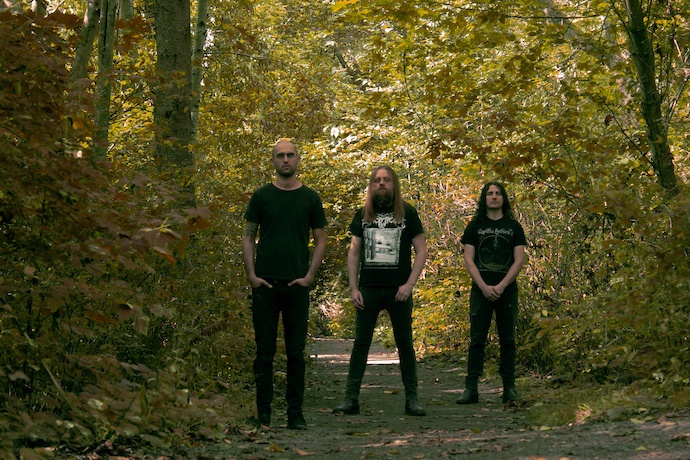
photo by Lauren Lamp
Bell Witch lyrics go hand-in-hand with oppressive, grim, and ceremonial music and they deal with life, death, the space in-between, and ghosts. Erik, how much do these themes appear in Aerial Ruin’s lyrics (if at all). Does Stygian Bough have its own voice or is at an amalgam of Bell Witch and Aerial Ruin?
EM: Aerial Ruin lyrics are largely a meditation on the loss of the self and the spiritual perspective derived therein, so there is a natural parallel between that and the purgatorial ghostly themes of Bell Witch. Stygian Bough could be said to be reflecting both these paths and also beginning one of its own.
The lyrics are largely a “sequel” of sorts to the song ‘Rows (of endless waves)’ which is the first Bell Witch song I sang and collaborated on from the Longing album. That song is about the ghost of a king trapped offshore, floating on rows of waves, wishing to reach the land so he can regain bodily form and reconquer his kingdom. The ghost-king could perhaps also be a metaphor for humanity and its sway over the planet and other species. On Stygian Bough Volume 1 he turns his gaze from returning to life and the bodily form and instead travels towards death; this album could be said to reflect that journey but is also quite a stream of consciousness.
BELL WITCH and AERIAL RUIN – The Bastard Wind
Recently I’ve watched two movies, Southbound and Sam Was Here, dealing with… lets say… “after-death experiences” or purgatory… Bands and projects like yours always have one foot in this territory with your songs. Are you afraid that you create your own purgatory, your own Bardo, with the images and themes you breed through your songs?
EM: No, I think these types of lyrical wanderings are an attempt to explore what might be there, which is certainly not something permanently created by our human minds in my opinion. It may be an extension of our human selves but we are still exploring a “place”, not creating one as far as how I see it. I have not seen those films though.
DD: I’m unfortunately unfamiliar with those movies…maybe I’ll have to look into them! I think I view music and other types of art as escapes, so they become anything but a purgatory. If purgatory is being trapped, playing music is the escape. If life is purgatory, music is elevation from it. Is that cliché? I bet Erik and Jesse would write something much less cliché and I’ll hate them for it.
Dylan, a few years ago in one interview you talked about what ghosts are elements of our psyche. How conscious is the way you write your music? Do you feel the hand of your ghosts behind some songs?
DD: I think the ghosts in Bell Witch songs could also represent the hellish parts of life that are inescapable. If ghosts are trapped in a world in between life and death, I think there are many correlations that can be made about various situations in which we’re each trapped in between worlds in our own lives. An easy example would be a job — everyone has felt trapped in a job they didn’t want but couldn’t leave. A more complicated example would be watching a loved one die.
That being said, I do tend to believe that ghosts can be a representation of our own psyche. I think sometimes I do write the lyrics to convey the feelings I’m having or have had in regards to being trapped in places in my own life. There have been times when putting the situation into ink and pondering it has helped me find the way out
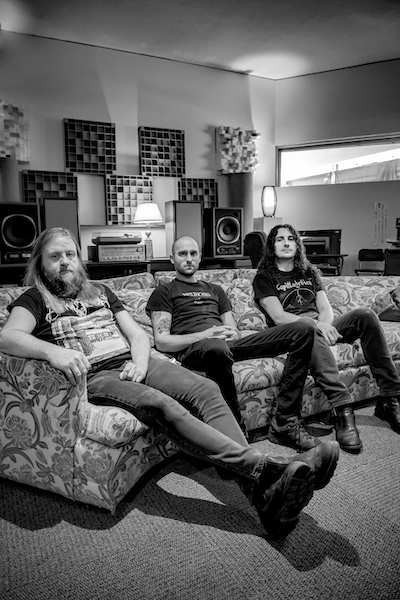
photo by Makenzie Stone
Dylan, have you faced moments during the recording of previous Bell Witch albums when your bass is not enough to express certain vibes or create the right mood? How has writing with a guitar player been? Would you add guitar to a future Bell Witch release?
DD: With Bell Witch there has never been a need for guitar. I’ve always felt like bass covers enough ground and that the addition of a guitar would be unnecessary. With Stygian Bough we wanted to explore the idea of that voicing with both acoustic and electric guitars.
Dylan, there was this striking turn in the Mirror Reaper album when you started to play a kind of reflection of the album’s first half. Do you have tricks like this in Stygian Bough? What are your favorite moments on this album? Something that makes you proud of some solutions?
DD: The Stygian Bough record doesn’t have that specific approach, but I do think the track placement flows in a fashion that a song would, were we to have written it as such. Of course, the songs were not written to go together the way Mirror Reaper was, though both parts of ‘Heaven Torn Low’ were written together, as well as the ‘Prelude’ before ‘The Unbodied Air’. I think my favorite part of the record is the acoustic intro. That was the first part we worked on together and it still does the trick every time I listen to it. I think ‘The Unbodied Air’ is my favorite track as a whole, however.
BELL WITCH and AERIAL RUIN – Heaven Torn Low II (the toll)
A kind of clichéd question, but this time it’s really interesting for me… Bell Witch is a very rare example of quite a successful funeral doom oriented band. Who would you name as your teachers in funeral ceremonies? Are you into those few early bands like Thergothon, Skepticism, and Mournful Congregation, or are you into “newer” outfits like Ahab?
DD: Thergothon, Skepticism, and Mournful Congregation are all some of my personal favorites. Worship, Asunder, Corrupted, and Esoteric are also in that list. Ahab is great! Their first two albums are personal favorites. One of my favorite characteristics of the genre is that few bands sound identical to the others; each has a unique approach. I don’t think this can be said of many other sub-genre’s under the heavy metal umbrella. If I had a dollar for every band that sounded identical to Black Sabbath I would have enough money to buy every album of every band that sounded exactly like Venom etc.
You write songs about death — well, most metal bands write about it. Has the current pandemic situation changed your attitude towards this topic?
DD: Absolutely not. Death is for certain in life, of course. One of the many fascinating things about it is that nobody has any idea about where it leads. All of our lives will be filled with it, and while maybe some of us will get accustomed to that, none of us will ever have any real idea what to expect until the day we experience it. This is the ultimate mystery of all of our lives. There I go being cliche again!
EM: Not directly. This album was written before the pandemic. As far as future material goes the pandemic will not change my focus on death and spirituality. My guess is I will not write about covid-19 specifically or directly but it will likely influence future writings in more subtle ways. However, it remains to be seen how future lyrical themes will evolve.
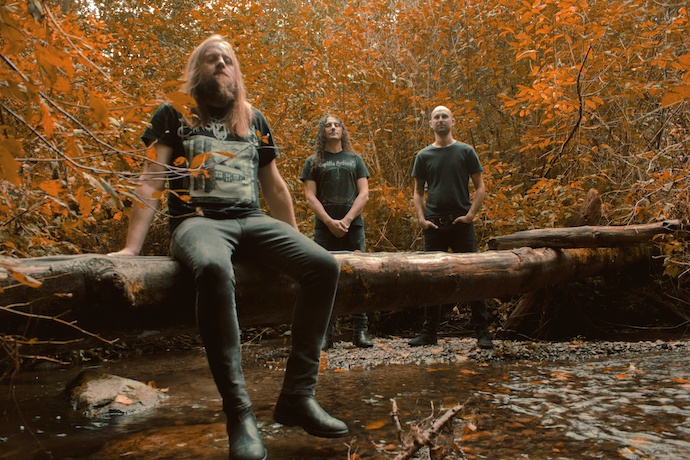
photo by Lauren Lamp
The album’s title leaves space for a second volume of Stygian Bough. Do you already have it written or is it just a suggestion?
EM: I wrote and demoed about 20 minutes’ worth of new material a few months back. We will use that as a starting point for our next release. I am sure when we all start writing together we will have lots of material. So we are definitely planning a Volume 2.
DD: We have some material that was left over from Volume 1. In addition, Erik sent me a lengthy track that we will probably begin working on within the next month. Volume II is in the works!
Live performances represent a rewarding side of being in a band. Do you aim to perform Stygian Bough live when the pandemic situation is stable?
EM: Absolutely. We had a year of heavy touring planned which we were very sad to cancel. We hope to make up for that in 2021 if it is safe to do so by then.
DD: We had a US and two full European tours booked upon the outbreak of the pandemic. Within a few weeks all of them were canceled or postponed. Hopefully we can pick up where we left off as soon as shows begin happening again.
Stygian Bough I:
https://bellwitch.bandcamp.com/album/stygian-bough-volume-i
Aerial Ruin:
https://www.facebook.com/aerialruin/
https://aerialruin.bandcamp.com/
Bell Witch:
https://www.facebook.com/BellWitchDoom/
https://bellwitch.bandcamp.com/

deux puissantes forces musicales du doom avant-garde
Excellentes photographies du studio!
Belle interview et journalisme